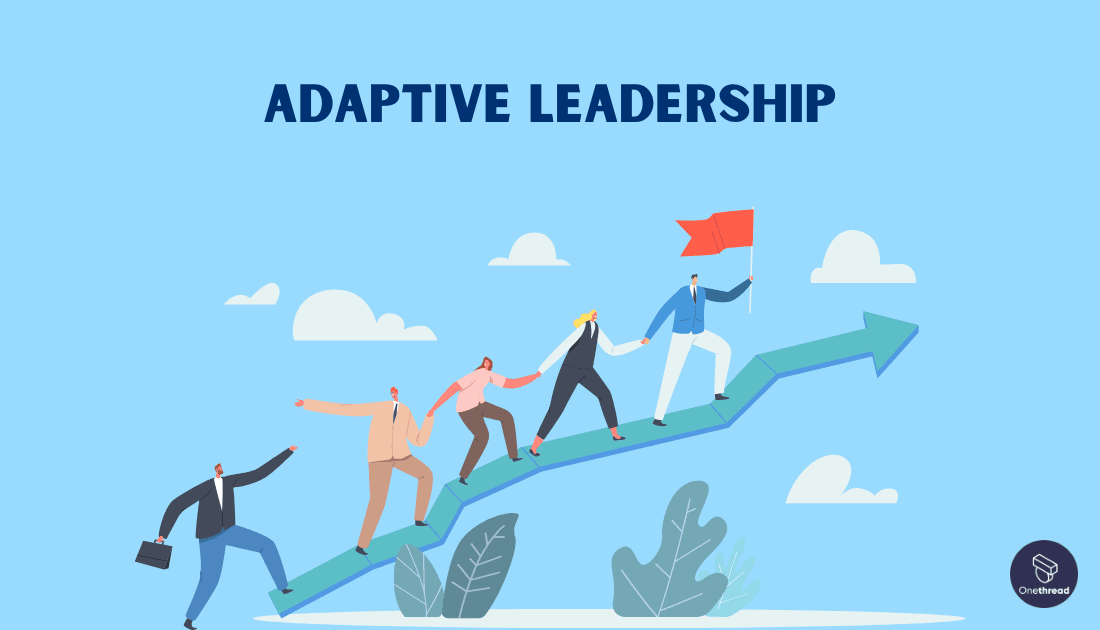In today’s swiftly changing business landscape, adaptive leadership stands tall as a pivotal approach. Adaptive leadership isn’t just a trendy phrase—it’s a dynamic response to complex, ever-evolving challenges.
Rooted in flexibility and forward-thinking, this leadership style recognizes that in our modern era, over 90% of companies face challenges that defy traditional solutions.
With 75% of organizations ranking adaptability as a “top needed skill in leaders,” adaptive leadership is emerging as the answer. So, what is adaptive leadership, and why is it becoming increasingly vital?
What Is Adaptive Leadership?
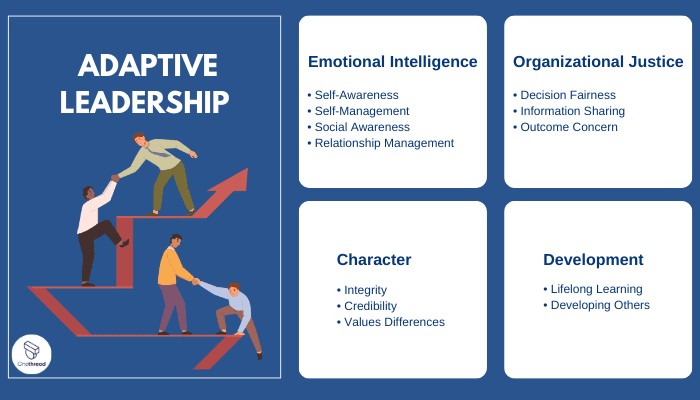
Adaptive leadership isn’t just a buzzword; it’s a methodology designed to tackle problems that lack clear solutions. Born out of the need to adapt and evolve, the adaptive leadership theory has its roots in the late 20th century when rapid technological and societal changes began reshaping industries.
But what is it, and how does it differ from traditional leadership concepts?
While traditional leadership often relies on a top-down approach with the leader as the ultimate decision-maker, adaptive leadership empowers team members to tackle challenges collaboratively.
This method focuses on cultivating an environment where individuals can adapt to challenges rather than relying solely on established procedures.
The concept stems from a simple yet profound understanding that in an ever-changing landscape, the ability to adapt is paramount. Over the decades, as change accelerated, this theory has grown from a niche idea into a mainstream methodology embraced by forward-thinking organizations worldwide.
Technical vs. Adaptive Challenges: A Deep Dive
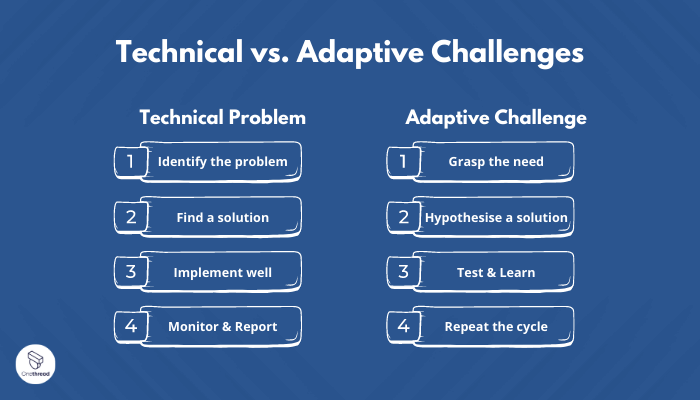
Challenges in the modern business landscape come in various forms. To address them effectively, it’s crucial to identify their nature.
Technical Challenges: These are the problems we’ve seen before. They have clear solutions, often based on past experiences or expertise. Think of a broken computer—it needs a specific fix. Technical problems have predefined answers and can typically be addressed by current know-how. They’re the puzzles we know how to solve.
Adaptive Challenges: Now, this is where the waters get murky. Adaptive challenges don’t come with a manual. They’re complex, requiring fresh perspectives and novel solutions. They force leaders to change their approach, question the status quo, and explore unfamiliar territories. These challenges might involve addressing a company’s cultural issues or navigating a brand-new market. The roadmap? It’s yet to be drawn.
In essence, while technical challenges ask, “How do we fix this with our existing tools?”, adaptive challenges prompt, “How do we think outside the box to navigate this unfamiliar territory?”
Recognizing the type of challenge faced is the first step in crafting a successful strategy. With technical problems, lean on expertise. For adaptive challenges, cultivate innovation and flexibility. By distinguishing between the two, leaders can pave the way for effective problem-solving.
Aspect | Technical Challenges | Adaptive Challenges |
Nature | Well-defined, specific issues | Complex, multifaceted issues |
Solution Approach | Known solutions can be applied | Requires new approaches |
Expertise | Typically solved by experts | Requires collective intelligence |
Problem Framing | Clear problem definition | Problem definition evolves |
Change Complexity | Low complexity | High complexity |
Resistance | Minimal human resistance | Often met with resistance |
Time Frame | Can often be resolved quickly | May require long-term efforts |
Role of Authority | Authority-driven solutions | Requires adaptive leadership |
Risk | Lower risk of failure | Higher risk of failure |
Skill Development | Focuses on existing skills | Encourages learning and growth |
Example | Fixing a software bug | Adapting to a changing market |
Outcome Expectation | Clear outcome and goal | Evolving and shifting outcomes |
Real-life Examples of Technical and Adaptive Challenges
Navigating challenges is an everyday affair for many of us. But understanding the nature of these challenges can better equip us to tackle them head-on. Let’s take a look at real-world scenarios to differentiate between technical and adaptive challenges.
Technical Challenge Example: Printer Malfunction
Imagine walking into your office, attempting to print an important document, only to find the printer’s not working. The solution? A simple diagnostic. Maybe it’s out of ink, has a paper jam, or needs a software update. These problems have clear solutions based on prior knowledge or a quick consultation with the manual.
Adaptive Challenge Example: Employee Morale Drop
Now, consider a more complex scenario. Over the past few months, you’ve noticed a significant drop in employee morale and productivity. There’s no one-size-fits-all answer here.
Boosting morale might involve revamping company culture, addressing internal communication gaps, or even re-evaluating workload distribution. Leaders must think creatively, involve their teams, and be ready to adapt to find effective solutions.
While technical challenges are the “quick fixes” we often encounter, adaptive challenges compel us to dig deeper, challenge our assumptions, and think innovatively. By recognizing the nature of the obstacle ahead, we can tailor our approach to conquer it effectively.
Core Principles That Define Adaptive Leadership
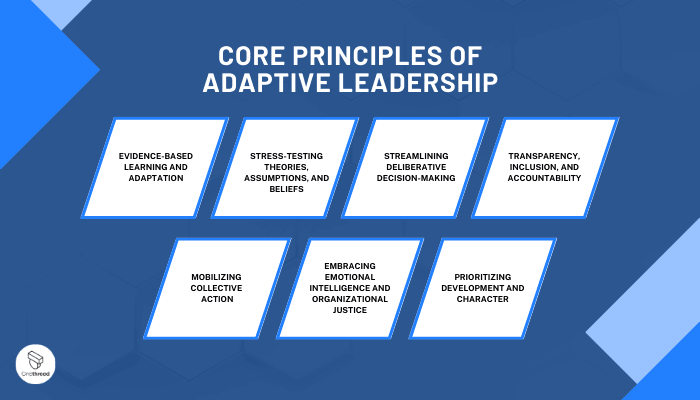
Adaptive leadership, unlike its more conventional counterparts, isn’t about a single solution or a one-size-fits-all approach. Instead, it delves into understanding the nuances of challenges and tailors solutions accordingly. At its heart, adaptive leadership is anchored in several foundational principles. Let’s delve into these principles to grasp the essence of this dynamic leadership style.
Evidence-based Learning and Adaptation
Adaptive leadership emphasizes decisions rooted in evidence. It’s not about acting on a whim but about making informed choices. Leaders are encouraged to gather data, analyze trends, and, most crucially, be willing to adjust strategies based on what the evidence indicates.
This continuous loop of learning and adapting ensures that strategies remain relevant and effective.
Stress-testing Theories, Assumptions, and Beliefs
It’s easy to get caught in the trap of “this is how we’ve always done it.” Adaptive leaders, however, challenge this mindset. They proactively question the status quo, stress-test prevailing theories, and are open to debunking long-held beliefs if they no longer serve the organization’s goals.
Streamlining Deliberative Decision-making
Adaptive leadership doesn’t equate to hasty decisions. Deliberation is vital. However, the focus is on making this process efficient. By gathering diverse inputs, encouraging open dialogue, and swiftly moving through the decision-making process, adaptive leaders ensure that agility doesn’t compromise accuracy.
Transparency, Inclusion, and Accountability
In an adaptive leadership framework, hiding behind closed doors isn’t the norm. Leaders prioritize transparency, ensuring that team members are informed about both successes and setbacks. Additionally, inclusivity is championed—diverse voices lead to richer insights.
And transparency and inclusion naturally follow accountability. Every decision, action, or inaction is owned, fostering a culture of responsibility.
Mobilizing Collective Action
Adaptive leadership understands the power of the collective. Instead of a top-down approach, adaptive leaders mobilize entire teams or organizations. They recognize that the best solutions often arise from collaborative efforts, where varied perspectives merge to form innovative strategies.
Embracing Emotional Intelligence and Organizational Justice
Beyond strategy and decision-making, adaptive leadership deeply values the human element. Leaders are tuned into their own emotions and those of their teams.
This emotional intelligence enables them to navigate complex interpersonal dynamics, ensuring that every team member feels valued and heard. Paired with a commitment to organizational justice, it ensures fairness and equity in all dealings.
Prioritizing Development and Character
An adaptive leader is, above all, committed to growth—both personal and organizational. There’s a continual pursuit of knowledge and skill enhancement. Moreover, the character takes center stage. Integrity, authenticity, and resilience form the backbone of their leadership ethos.
In a world where change is the only constant, adaptive leadership offers a beacon. It’s not just about steering through calm waters but skillfully navigating the storms. Rooted in these core principles, adaptive leadership provides a roadmap for organizations to thrive amidst uncertainty.
Unique Traits that Set Apart Adaptive Leaders
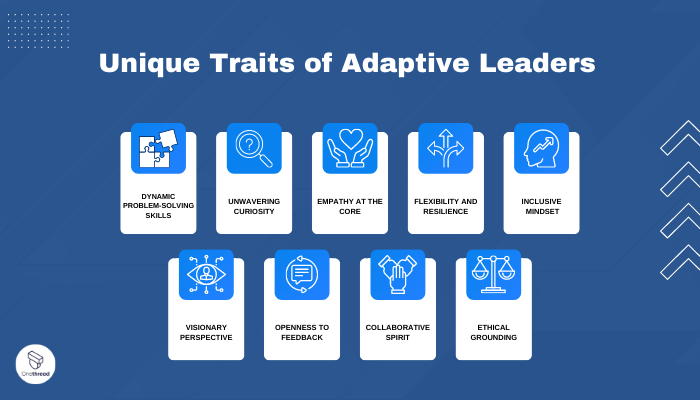
In a rapidly evolving business landscape, certain leadership styles stand out, effectively bridging gaps and maneuvering through uncertainties. Adaptive leadership is one such style.
But what truly sets adaptive leaders apart from the rest? The answer lies in their unique traits, which equip them to handle complexities and champion change. Let’s dive deep into these distinguishing characteristics.
Dynamic Problem-solving Skills
While traditional leaders may have a set playbook for issues, adaptive leaders thrive on improvisation. They approach problems with a dynamic mindset, ready to pivot and adjust solutions based on emerging insights. The ability to think on their feet and be solution-oriented is a hallmark trait.
Unwavering Curiosity
These leaders have an insatiable thirst for knowledge. They’re continually asking questions, seeking feedback, and looking for better ways to do things. This curiosity pushes them to explore new avenues and keeps stagnation at bay.
Empathy at the Core
An adaptive leader isn’t just business-focused. They genuinely care about their team. This empathy allows them to connect on a deeper level, understanding individual motivations, fears, and aspirations. Such connections foster loyalty and boost team morale.
Flexibility and Resilience
Change, especially unexpected change, is a constant in today’s world. Adaptive leaders are flexible, able to shift strategies without hesitation. More importantly, they bounce back from setbacks with increased determination, embodying resilience.
Inclusive Mindset
These leaders value diversity—not just in terms of demographics but also in thoughts and perspectives. They create environments where every voice counts, understanding that inclusivity often leads to richer, more innovative solutions.
Visionary Perspective
While they are adept at managing day-to-day tasks, adaptive leaders always have an eye on the horizon. They’re visionaries, planning for the future, anticipating trends, and ensuring that the organization is always a step ahead.
Openness to Feedback
No one likes criticism, but adaptive leaders welcome it. They see feedback, both positive and negative, as a tool for growth. This openness encourages a culture where continuous improvement is not just encouraged but celebrated.
Collaborative Spirit
Adaptive leaders recognize that they don’t have all the answers. Hence, they actively foster a collaborative environment, pooling together expertise and insights. They know that collective brainstorming can lead to breakthrough ideas.
Ethical Grounding
In the midst of adaptability and change, these leaders remain rooted in ethics. They prioritize doing what’s right over what’s expedient, ensuring that the organization’s integrity remains uncompromised.
Adaptive leadership, with its distinct traits, is shaping the future of leadership paradigms.
In an unpredictable world, these unique characteristics empower adaptive leaders to navigate challenges, inspire teams, and drive success. They’re not just managing change; they’re spearheading it, setting new standards for what effective leadership truly means.
Challenges and Dangers Associated with Implementing Adaptive Leadership
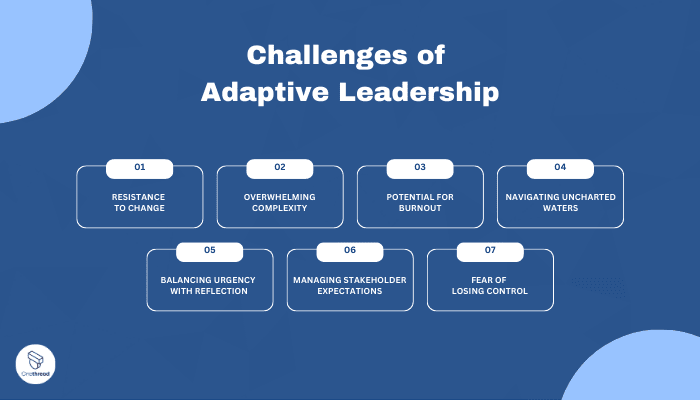
Delving deep, we uncover the hurdles and potential challenges that lie in the path of embracing adaptive leadership.
Resistance to Change
Human nature is often averse to change. Implementing adaptive leadership can face pushback from teams accustomed to traditional leadership styles. This resistance can stall initiatives and hinder the transformative potential of adaptive strategies.
Overwhelming Complexity
Adaptive challenges, by nature, are complex and multifaceted. Addressing them without clear guidance can lead to confusion, making it challenging to pinpoint actionable solutions amidst the chaos.
Potential for Burnout
Continuously adapting to new scenarios can be mentally taxing. Leaders might find themselves perpetually in problem-solving mode, leading to exhaustion and decreased efficiency over time.
Navigating Uncharted Waters
Without precedent to rely on, adaptive leaders often find themselves in unfamiliar territory. This can result in feelings of vulnerability, with the fear of making mistakes looming large.
Balancing Urgency with Reflection
The rapid pace of change can create a sense of urgency. However, adaptive leadership requires thoughtful reflection. Striking the right balance between quick decisions and deep introspection can be a tightrope walk.
Managing Stakeholder Expectations
Stakeholders often expect swift solutions. In adaptive leadership, where challenges are navigated in real-time, meeting these expectations can be daunting, especially when solutions aren’t immediately apparent.
Fear of Losing Control
Adaptive leadership encourages decentralized decision-making. Traditional leaders might perceive this as a loss of control, creating hesitancy in fully embracing this approach.
Conclusion
Adaptive leadership isn’t just a trend; it’s a transformative approach for our rapidly changing world. Leaders today face unprecedented challenges, requiring nimbleness and a deep understanding of complex dynamics.
This leadership style offers a roadmap, guiding organizations through the maze of change with resilience and foresight. By embracing adaptability, leaders not only tackle immediate issues but also cultivate a culture prepared for future uncertainties.
In essence, adaptive leadership is less about quick fixes and more about long-term growth. It’s a mindset, a commitment, and an essential tool for modern success.Looking to cultivate adaptive leadership in your organization? Consider partnering with Onethread for comprehensive training and insights.
